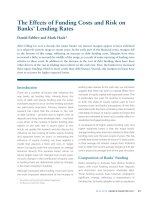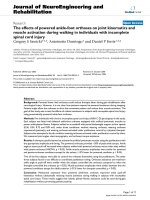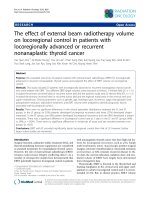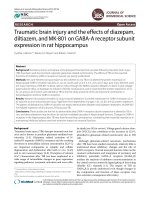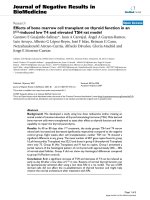The effects of perioperative anesthesia and analgesia on immune function in patients undergoing breast cancer resection: A prospective randomized study
Bạn đang xem bản rút gọn của tài liệu. Xem và tải ngay bản đầy đủ của tài liệu tại đây (454.08 KB, 7 trang )
Int. J. Med. Sci. 2017, Vol. 14
Ivyspring
International Publisher
970
International Journal of Medical Sciences
2017; 14(10): 970-976. doi: 10.7150/ijms.20064
Research Paper
The Effects of Perioperative Anesthesia and Analgesia on
Immune Function in Patients Undergoing Breast Cancer
Resection: A Prospective Randomized Study
Jin Sun Cho1*, Mi-Hyang Lee2, 3*, Seung Il Kim4, Seho Park4, Hyung Seok Park4, Ein Oh1, Jong Ho Lee2, 5, 6,
and Bon-Nyeo Koo1
1.
2.
3.
4.
5.
6.
Department of Anesthesiology and Pain Medicine, Anesthesia and Pain Research Institute, Yonsei University College of Medicine, Seoul, Republic of Korea;
National Leading Research Laboratory of Clinical Nutrigenetics/Nutrigenomics, Department of Food and Nutrition, College of Human Ecology, Yonsei University,
Seoul, Republic of Korea;
Korea Ginseng Corporation Research Institute, Korea Ginseng Corporation, Daejeon, Republic of Korea;
Department of Surgery, Yonsei University College of Medicine, Seoul, Republic of Korea;
Department of Food and Nutrition, Brain Korea 21 PLUS Project, College of Human Ecology, Yonsei University, Seoul, Republic of Korea;
Research Center for Silver Science, Institute of Symbiotic Life-TECH, Yonsei University, Seoul, Republic of Korea.
* Jin Sun Cho and Mi-Hyang Lee are co-first authors.
Corresponding authors: Jong Ho Lee, Department of Food and Nutrition, Yonsei University, 50 Yonsei-ro, Seodaemun-gu, Seoul 03722, Republic of Korea Fax:
+82-2-364-2951/ Tel: +82-2-2123-8385/ E-mail: Bon-Nyeo Koo, Department of Anesthesiology and Pain Medicine, Anesthesia and Pain Research
Institute, Yonsei University College of Medicine, 50-1 Yonsei-ro, Seodaemun-gu, Seoul 03722, Republic of Korea Fax: +82-2-364-2951/ Tel: +82-2-2227-3835/ E-mail:
© Ivyspring International Publisher. This is an open access article distributed under the terms of the Creative Commons Attribution (CC BY-NC) license
( See for full terms and conditions.
Received: 2017.03.14; Accepted: 2017.06.18; Published: 2017.08.18
Abstract
Introduction: Perioperative anesthesia and analgesia exacerbate immunosuppression in
immunocompromised cancer patients. The natural killer (NK) cell is a critical part of anti-tumor
immunity. We compared the effects of two different anesthesia and analgesia methods on the NK cell
cytotoxicity (NKCC) in patients undergoing breast cancer surgery.
Methods: Fifty patients undergoing breast cancer resection were randomly assigned to receive
propofol-remifentanil anesthesia with postoperative ketorolac analgesia (Propofol-ketorolac groups) or
sevoflurane-remifentanil anesthesia with postoperative fentanyl analgesia (Sevoflurane-fentanyl group).
The primary outcome was NKCC, which was measured before and 24 h after surgery. Post-surgical
pain scores and inflammatory responses measured by white blood cell, neutrophil, and lymphocyte
counts were assessed. Cancer recurrence or metastasis was evaluated with ultrasound and whole body
bone scan every 6 months for 2 years after surgery.
Results: The baseline NKCC (%) was comparable between the two groups (P = 0.082). Compared with
the baseline value, NKCC (%) increased in the Propofol-ketorolac group [15.2 (3.2) to 20.1 (3.5), P =
0.048], whereas it decreased in the Sevoflurane-fentanyl group [19.5 (2.8) to 16.4 (1.9), P = 0.032]. The
change of NKCC over time was significantly different between the groups (P = 0.048). Pain scores
during 48 h after surgery and post-surgical inflammatory responses were comparable between the
groups. One patient in the Sevoflurane-fentanyl group had recurrence in the contralateral breast and no
metastasis was found in either group.
Conclusions: Propofol anesthesia with postoperative ketorolac analgesia demonstrated a favorable
impact on immune function by preserving NKCC compared with sevoflurane anesthesia and
postoperative fentanyl analgesia in patients undergoing breast cancer surgery.
Key words: anesthesia; analgesia; breast cancer; immunity; natural killer cell.
Introduction
Surgical resection is one of the primary
treatments for solid tumors, but the dissemination of
tumor cells into the blood and lymphatic systems
inevitably occurs during surgery. Whether the
Int. J. Med. Sci. 2017, Vol. 14
residual tumor cells lead to clinical deterioration
depends on the balance between perioperative factors
promoting cancer survival and growth and the host’s
anti-tumor
defenses
[1].
Surgery-related
neuroendocrine stress responses, anesthetics, and
opioid analgesics are factors known to adversely
affect the anti-tumor immune defenses [2].
Natural killer (NK) cells are a critical part of
innate immunity, acting as the main defense against
the spread of cancer [3]. Reduced NK cell cytotoxicity
(NKCC) is associated with poor cancer prognosis in
breast, colon, and prostate cancers [4-6]. Especially in
breast cancer patients, the level of NKCC is inversely
correlated with the stage and metastasis of cancer [4].
To date, there have been few prospective studies
comparing the effects of perioperative anesthetic and
analgesic agents on NKCC in patients undergoing
cancer surgery. Previous experimental studies have
shown both detrimental and protective effects of
certain anesthetics and analgesics on immune
function. Volatile anesthetic agents, including
sevoflurane and desflurane, decreased NKCC [7],
whereas propofol did not suppress NKCC [8].
Fentanyl suppressed NK cell function [9], whereas
non-steroidal anti-inflammatory drugs (NASIDs)
reversed NKCC suppression [10]. Based on these
results, we hypothesized that avoiding volatile
anesthetics and opioid analgesics might attenuate the
immunosuppression in the perioperative periods. In
this prospective randomized study, we compared the
effects of two different anesthetic and analgesic
methods on NKCC in patients undergoing breast
cancer surgery.
Patients and Methods
This study was approved by the Institutional
Review Board and Hospital Research Ethics
Committee of Severance Hospital, Yonsei University
Health System, Seoul, Korea, on February 2014
(#4-2013-0937). It was registered at clinicaltrial.gov on
March 2014 (NCT02089178). Patients (20-65 years old)
who underwent elective surgery for breast cancer and
had an American Society of Anesthesiologists (ASA)
physical status classification of I to III were included.
The exclusion criteria were renal or hepatic
impairment, a body mass index > 35 kg/m2,
immunosuppressive therapy, immune disorders,
steroid administration within the last six months,
metastasis, or radiotherapy or chemotherapy before
surgery. Written formed consent was obtained from
all of patients. A total of 50 patients were randomly
assigned into one of the study groups (25 patients
each) using a computer-generated random number
table. In the Propofol-ketorolac group, patients were
anesthetized with propofol and remifentanil and
971
received ketorolac after surgery. In the Sevo-fentanyl
group, patients were anesthetized with sevoflurane
and
remifentanil
and
received
fentanyl
postoperatively. Assignments were concealed in
sealed envelopes and the randomization was not
stratified or blocked.
In the operating theatre, patients received
glycopyrrolate 0.2 mg and were applied with routine
ASA monitoring, including electrocardiography,
peripheral oxygen saturation, and blood pressure.
Before anesthetic induction, a peripheral venous
cannula was inserted to obtain a blood sample before
and after surgery. In the Propofol-ketorolac group,
propofol was administered using a target-controlled
infusion (Orchestra®Base Primea, Fresenius Vial,
Sévres, France) with the modified Marsh model. A
target plasma concentration of propofol was 4 μg/ml
initially, and then adjusted in 0.2 μg/ml increments.
In the Sevo-fentanyl group, anesthesia was induced
with propofol 1.5 to 2 μg/kg and maintained with
sevoflurane. The concentrations of propofol and
sevoflurane were titrated to maintain the bispectral
index score in the range of 40-60. In addition to
anesthetic agents, remifentanil was infused in both
groups
to maintain hemodynamic stability
intraoperatively. Low-dose remifentanil infusion did
not impair NKCC [11]. Remifentanil was infused
using a target-controlled infusion to achieve an
effect-site concentration of 1.5 ng/ml at induction and
then between 3 and 5 ng/ml for maintenance.
Rocuronium 0.6 mg/kg was administered to facilitate
tracheal intubation. Mean blood pressure and heart
rate were maintained within 25% of baseline. At the
end of the surgery, all patients received neostigmine
40 μg/kg and glycopyrrolate 5 μg/kg for reversal of
neuromuscular block and ramosetron 0.3 mg for
postoperative nausea and vomiting prophylaxis. At
the end of surgery, the Propofol-ketorolac group
received ketorolac 60 mg and the Sevo-fentanyl group
received fentanyl 50 μg for acute pain relief.
The primary aim was to compare the effects of
two anesthetic and analgesic methods on the immune
function assessed by NKCC, measured preoperatively
and at 24 h postoperatively. Other outcome measures
included postoperative pain scores, IL-2 levels, and
inflammatory responses assessed by white blood cell,
neutrophil, and lymphocyte counts. The incidence of
cancer recurrence or metastasis was evaluated with a
breast ultrasound, abdomen ultrasound, and whole
body bone scan every 6 months after surgery.
Assay for natural killer cell cytotoxicity
Blood samples were obtained before and at 24 h
after surgery. Whole blood was mixed with the same
volume of RPMI 1640 (Gibco, Invitrogen Co, USA),
Int. J. Med. Sci. 2017, Vol. 14
and the mixture was laid on Histipaque®-1077 (Sigma,
CA, USA) and centrifuged (2000 rpm for 20 min at
10°C). Then, a thin layer of peripheral blood
mononuclear cells (PBMCs) was harvested, washed
twice with RPMI 1640, and resuspended in RPMI 1640
containing streptomycin. NKCC was assessed using
the CytoTox 96® Non-Radioactive Cytotoxicity Assay
Kit (Promega Co., WI, USA). This colorimetric assay
quantitatively measures lactate dehydrogenase
(LDH), a stable cytosolic enzyme that is released upon
cell lysis, in much the same way that 51Cr is released in
a radioactive assay. PBMCs (effector cell) and K562
cells (targeted cell; 2 x 104 cells/well) were seeded in
the well in a ratio of 1.25:1 and incubated overnight at
37°C in 5% CO2. Finally, the NKCC of effector cells
was measured with a 2030 multilabel reader (VictorTM
X5, PerkinElmer, MA, USA) at 490 nm, and the
cytotoxicity percentage was calculated with as [12]:
% Cytotoxicity = [(Experimental – Effector
Spontaneous – Target Spontaneous) / (Target
Maximum – Target Spontaneous)] x 100
The maximum LDH release from target cells was
measured by using the lysis solution (Triton® X-100),
which should yield complete lysis of target cells and
subsequent release of cytoplasmic LDH into the
surrounding culture medium.
Assay for interleukin-2
IL-2 was measured in serum using a commercial
ELISA kit (Quantikine Human IL-2 ELISA Kit; R&D
System Inc., MN, USA) preoperatively and at 24 h
after surgery. The absorbance was read at 450 nm
using a Spectra Max 190 micro-plate reader
(Molecular Devices, CA, USA).
Pain scores
Pain scores were assessed using a 11-point
numerical rating scale (NRS, 0 = no pain to 10 = worst
pain) at postoperative 30 min, 6 h, 24 h, and 48 h. For
immediate
postoperative
analgesia,
the
Propofol-ketorolac group received ketorolac 60 mg
and the Sevo-fentanyl group received fentanyl 50 μg
at the end of surgery. In the post-anesthesia care unit,
propacetamol 2 g in the Propofol-ketorolac group or
fentanyl 50 μg in the Sevo-fentanyl group was
available as an additional analgesic for patients with a
NRS ≥ 4. In the ward, both groups received tramadol
50 mg as a rescue analgesic, which does not suppress
NKCC [13].
Statistics
No previous study was available to inform
assumptions regarding changes of NKCC following
two different anesthetic and analgesic methods. We
calculated a sample size based on preliminary results
972
for the first five patients of each group, and estimated
that 22 patients in each group would be required to
detect a mean difference of 10% and standard
deviation of 10% in the NKCC after surgery with 90%
power at a significance of P < 0.05. We factored in a
10% dropout rate and enrolled 25 patients in each
group.
Statistical analyses were performed with IBM
SPSS 20.0 (IBM Corp., Armonk, NY, USA) and SAS 9.2
(SAS Institute Inc., Cary, NC, USA). Continuous
variables were analyzed with the independent t-test
or Mann-Whitney U test, after testing for normality of
distribution
using
Kolmogorov-Smirnov
test.
Categorical variables were analyzed with χ2 test or
Fisher exact test. Variables measured repeatedly, such
as NKCC, IL-2, total leukocyte, neutrophil, and
lymphocyte counts, and neutrophil-lymphocyte-ratio
(NLR) were analyzed with a linear mixed model, with
patient indicator as a random effect and with group,
time, and group-by-time as fixed effects. The
group-by-time interaction assesses whether the
change over time differs between groups. Post-hoc
analyses with the Bonferroni correction were
performed for multiple comparisons when variables
with repeated measures showed significant
differences between groups. A P value < 0.05 was
considered statistically significant.
Results
Of 50 patients enrolled, one patient in each
group was eliminated due to concurrent breast
reconstruction surgery. The remaining 48 patients
completed the study without any complications.
Patient characteristics and operation details were
comparable between the two groups (Table 1).
Natural killer cell cytotoxicity
The baseline NKCC (%) was not statistically
different between the two groups (P = 0.082).
Compared to the baseline, NKCC (%) increased after
surgery in the Propofol-ketorolac group [mean (SEM)
preoperative to postoperative; 15.2 (3.2) to 20.1 (3.5), P
= 0.048], whereas it decreased in the Sevo-fentanyl
group [19.5 (2.8) to 16.4 (1.9), P = 0.032]. The change of
NKCC over time was significantly different between
the groups (P = 0.048) (Figure 1).
Serum concentration of interleukin-2
No significant postoperative change was seen in
IL-2 levels in either group [median (IQR) preoperative
to postoperative; 2.75 (1.61, 4.97) to 3.16 (1.97, 5.52), P
= 0.721 in the Propofol- ketorolac group, and 2.65
(2.15, 3.96) to 2.81 (2.00, 4.62), P = 0.523 in the Sevofentanyl group]. The change of IL-2 levels over time
was not significant between the groups (P = 0.620).
Int. J. Med. Sci. 2017, Vol. 14
973
Table 1. Patient characteristics and operation details
Variables
Age (years)
BMI (kg/m2)
ASA class II/III
Type of surgery
Partial mastectomy
Total mastectomy
Radical mastectomy
Lymph node involvement
Positive/ negative
Duration of operation (min)
Duration of anesthesia (min)
Dose of remifentanil (μg/kg/min)
Propofol-ketorolac group
(n = 24)
55.4 ± 7.0
23.6 ± 3.0
9/ 0
Sevo-fentanyl group
(n = 24)
55.7 ± 12.9
24.3 ± 3.7
6/ 3
P value
7
14
3
11
12
1
0.923
0.500
0.165
0.360
0.233
0.562
0.296
13 / 11
101.6 ± 30.9
132.8 ± 28.2
0.09 ± 0.02
10 / 14
99.7 ± 33.0
127.0 ± 34.7
0.08 ± 0.02
0.386
0.841
0.535
0.082
Values are mean ± standard deviation or number.
Propofol-ketorolac group, propofol-remifentanil anesthesia and postoperative ketorolac analgesia group; Sevo-fentanyl group, sevoflurane-remifentanil anesthesia and
postoperative fentanyl analgesia group; BMI, body mass index; ASA class, American Society of Anesthesiologists physical status classification.
Figure 1. Natural killer cell cytotoxicity before and after surgery NK cell, natural killer cell; Propofol-ketorolac group, propofol-remifentanil anesthesia and
postoperative ketorolac analgesia group; Sevo-fentanyl group, sevoflurane-remifentanil anesthesia and postoperative fentanyl analgesia group. The change of NK cell
cytotoxicity over time was significantly different between the groups (P Group x Time = 0.048).
Inflammatory response
Postoperative outcomes
The changes of the total leukocyte, neutrophil,
and lymphocyte counts and NLR over time were not
significant between the groups (Table 2). Lymphocyte
counts after surgery decreased in both groups
compared to the baseline, but the difference was
significant only in the Sevo-fentanyl group (P = 0.037).
One patient in the Sevo-fentanyl group had
recurrence in the contralateral breast 18 months after
surgery, and underwent a partial mastectomy. No
patient had metastasis in either group within two
years after surgery.
Pain score
Pain scores during the postoperative 48 h were
comparable between the two groups. In the
post-anesthesia care unit, 8 patients in the
Propofol-ketorolac group received propacetamol and
12 patients in the Sevo-fentanyl group received
fentanyl as an additional analgesic. The number of
patients requiring tramadol in the ward and total
doses given were comparable between two groups
(Table 3).
Discussion
During breast cancer surgery, patients who
received propofol-remifentanil anesthesia and
postoperative ketorolac analgesia exhibited preserved
NKCC compared with those who received
sevoflurane-remifentanil
anesthesia
and
postoperative fentanyl analgesia. Postoperative
inflammatory responses and the incidences of
short-term cancer recurrence and metastasis were not
different between the two anesthetic and analgesic
methods.
Int. J. Med. Sci. 2017, Vol. 14
974
Table 2. Total leukocyte, neutrophil, and lymphocyte counts
Variables
Leukocyte
(10-3/μL)
Time points
before surgery
at 24 h after surgery
Neutrophil
before surgery
(10-3/μL)
at 24 h after surgery
Lymphocyte
before surgery
(10-3/μL)
at 24 h after surgery
Neutrophil to lymphocyte ratio before surgery
at 24 h after surgery
Propofol-ketorolac group (n = 24)
6.05 ± 1.47
7.78 ± 1.62 *
3.37 ± 1.27
5.41 ± 1.35 *
1.99 ± 0.51
1.74 ± 0.51
1.76 ± 0.69
3.37 ± 1.27 *
Sevo-fentanyl group (n = 24)
6.83 ± 1.43
8.57 ± 1.88 *
4.09 ± 1.07
6.13 ± 1.56 *
2.15 ± 0.71
1.75 ± 0.66 *
2.13 ± 1.08
3.85 ± 1.46 *
P Groupⅹ
0.996
Time
0.988
0.538
0.841
Values are mean ± standard deviation.
Propofol-ketorolac group, propofol-remifentanil anesthesia and postoperative ketorolac analgesia group; Sevo-fentanyl group, sevoflurane-remifentanil anesthesia and
postoperative fentanyl analgesia group; PGroup × Time, P-value for the group × time interaction in the linear mixed model.
The baseline values were not different between the two groups. * P < 0.05 vs. before surgery.
Table 3. Pain scores and additional analgesic requirements
Pain score
at post-op 30 min
at post-op 6 h
at post-op 24h
at post-op 48 h
Worst pain score
during post-op 30 min
during post-op 30 min–6 h
during post-op 6–24 h
during post-op 24–48 h
Analgesic drugs
at the end of surgery (ketorolac, mg) (n) *
(fentanyl, μg) (n) *
during post-op 30 min (propacetamol, g) (n) *
(fentanyl, μg) (n)*
during post-op 30 min–6 h (tramadol, mg) (n)*
during post-op 6–24 h (tramadol, mg) (n) *
during post-op 24–48 h (tramadol, mg) (n) *
Propofol-ketorolac group (n = 24)
Sevo-fentanyl group (n = 24)
P value
2.8 ± 0.8
2.2 ± 0.7
1.9 ± 0.6
1.6 ± 0.7
2.7 ± 0.6
2.3 ± 1.1
2.1 ± 0.7
1.6 ± 0.8
0.476
0.642
0.315
0.941
4.0 ± 1.5
4.3 ± 1.9
2.5 ± 1.3
1.9 ± 0.4
4.0 ± 1.4
5.0 ± 2.5
3.3 ± 1.7
2.0 ± 1.0
0.923
0.271
0.104
0.828
60 (24)
0
2 (8)
0
47.9 ± 7.2 (12)
45.0 ± 11.2 (5)
0
0
50 (24)
0
75.0 ± 39.9 (12)
53.8 ± 13.9 (13)
60.0 ± 22.4 (5)
50 (1)
>0.999
>0.999
>0.999
>0.999
0.199 (0.773)
0.217 (>0.999)
0.35 (0.75)
Values are mean ± standard deviation or number.
Propofol-ketorolac group, propofol-remifentanil anesthesia and postoperative ketorolac analgesia group; Sevo-fentanyl group, sevoflurane-remifentanil anesthesia and
postoperative fentanyl analgesia group; post-op, postoperative; Pain score, a numerical pain intensity scale (0 = no pain, 10 = the worst pain); (n)*, number of patients
requiring analgesic drugs.
Compelling clinical and experimental evidences
have suggested that surgery and anesthesia cause a
transient period of immunosuppression, which may
encourage both the implantation of surgically
disseminated neoplastic cells and the growth of
existing micro-metastases [1, 2]. Anesthesia can
interact with the immune system, facilitating or
hindering tumor growth and metastasis. NK cells,
CD3- CD56+ lymphocytes, have direct cellular
cytotoxicity against tumor cells and act as the body’s
main defense against local tumor growth and
metastasis.[1, 3] Patients diagnosed with breast cancer
have inhibition and significantly lower levels of
NKCC than do healthy patients. Furthermore,
patients with more advanced breast cancer (stage 4)
have an increased proportion of immature and
non-cytotoxic NK cells in the blood than those with
stage 1-3 [4].
Anesthetic agents have exhibited different
effects on NKCC in animal and human studies.
Propofol preserved NKCC and cytotoxic T
lymphocyte activity and suppressed tumor growth.[8,
14] Propofol has cyclooxygenase (COX)-2 inhibiting
activity, reducing the production of prostaglandin E2
(PGE2), a mediator of pain and inflammation that
inhibits NKCC [15]. In contrast that propofol has only
minor effects on NK cells at clinically relevant
concentrations, volatile anesthetics have the dose- and
time-dependent suppressive effects on NK cells and T
lymphocytes. Isoflurane [16], sevoflurane [7], and
desflurane [7] were demonstrated to suppress NKCC.
In a rat model of lung tumor, halothane reduced
NKCC and increased lung tumor retention and
metastases, whereas propofol preserved NKCC [8].
These attributes of propofol and sevoflurane are
consistent with our results, which showed increased
NKCC in the Propofol-ketorolac group and decreased
NKCC in the Sevo-fentanyl group.
Both pain and opioid analgeiscs are known to
cause immunosuppression [1, 2]. Fentanyl and
morphine depressed NK cell function and markedly
increased tumor burden, whereas ketorolac reversed
Int. J. Med. Sci. 2017, Vol. 14
NKCC suppression [9, 10]. NSAIDs inhibit
prostaglandin synthesis via inhibition of the COX
enzyme and COX-2 inhibitors have anti-tumor and
anti-angiogenic properties [17]. As our two groups
showed comparable analgesic efficacies, the impact of
pain on immune function should have been the same
in both groups, eliminating pain as a contributing
factor to different NKCC between the groups.
Therefore, immunosuppressive effect of fentanyl
might contribute to decreased NKCC in the
Sevo-fentanyl group compared with preseved NKCC
in the Propofol-ketorolac group.
Antitumor responses in NKCC are activated by
various cytokines; and among those, IL-2 is an
important activator of NK cells [18]. IL-2
administration reversed the NKCC suppression
associated with surgery and significantly decreased
tumor incidence in an animal model [10]. In addition,
IL-2 activated human NK cells, effectively killing
colon carcinoma, in vitro [19]. We assessed IL-2 level
to exclude the possibility of different IL-2 level
between the groups before surgery and investigate if
NKCC change after surgery would be associated with
IL-2 change. We observed the significant increase of
IL-2 in both groups after surgery compared to before
surgery, but no significant difference was found
between the two groups.
Anesthetic and analgesic agents may affect the
concentrations of immunocompetent cells, resulting
in lymphopenia and neutrophilia [20]. A high NLR is
considered as a prognostic indicator for breast cancer
[21]. Suppression of lymphocytes is proportional to
the dose and duration of anesthetics use. Volatile
anesthetics increased the neutrophil and decreased
the lymphocyte [7, 22], and propofol also decreased
peripheral lymphocytes counts by reducing
proliferative responses of lymphocytes [23]. However,
propofol provided more effective protection for
circulating lymphocytes than sevoflurane [24].
Fentanyl induced a time-dependent apoptosis of
lymphocytes [25], and flurbiprofen showed similar
effects on lymphocyte level compared with fentanyl
[26]. In the present study, the neutrophil count and
NLR increased significantly after surgery in both
groups, whereas the lymphocyte decreased
significantly only in the Sevo-fentanyl group. Our
findings suggest that sevoflurane and fentanyl
induced more suppressive effect on lymphocytes
compared to propofol and ketorolac.
As detrimental effects of volatile anesthesia and
opioids on immune function have been identified,
regional anesthesia has been tried in an attempt to
reduce volatile anesthetics or opioid use. In breast
cancer surgery, patients who received propofol and
paravertebral block showed preserved NKCC
975
compared to those who received sevoflurane and
opioids [27]. However, the addition of spinal blockade
to halothane did not attenuate NKCC suppression
compared to halothane anesthesia alone or combined
with systemic morphine [28]. A recent meta-analysis
showed no association between regional anesthesia
and NK cell function [29]. Whereas there are
contraindications
such
as
coagulopathy
or
inflammation and the possibility of failure to perform
regional anesthesia, intravenous or volatile anesthesia
can be performed with little difficulties and few
contraindications. Considering the effects on immune
function, the anesthetic agent of choice in cancer
surgery would be propofol rather than volatile
anesthetics. In addition, non-opioid analgesics may be
ideal for the restoration of perioperative immune
competence rather than opioid.
Our study has some limitations. First, due to the
study design, the operating room staff could not be
blinded to the group allocation. However, the
investigators
who
conducted
follow-ups
postoperatively, including analysis of laboratory
findings and assessments of pain intensity, were
completely unaware of the patient’s group
assignment. Second, we used remifentanil for
intraoperative hemodynamic stability and tramadol
for postoperative pain control in both groups.
Although remifentanil and tramadol did not impair
NKCC [11, 13] and the doses were comparable
between the groups in the present study, the possible
impacts of remifentanil and tramadol on NKCC
cannot be excluded. Third, we could not discriminate
the respective effects of each drug on NKCC and
inflammatory responses. The differences of
postoperative NKCC between the groups might be
attributed
to
the
combined
effects
of
propofol-ketorolac and sevoflurane-fentanyl. Forth,
we used PBMCs as effector cells instead of isolating
NK cells. Although NK cell proportion varies
individually, the cytotoxic activity of PBMC and
separated NK cell samples was reported to be
correlated, indicating that both PBMC and separated
NK cell measurement methods are equally effective
tools for investigation of NK cell activity [30]. NKCC
using PBMC can provide natural circumstance like in
vivo environment [31]. Last, although cancer
metastasis within two year after surgery did not occur
in the present study, further evaluation of long-term
outcomes are needed to make a conclusion about
cancer recurrence or metastasis.
In conclusion, propofol anesthesia and
postoperative ketorolac analgesia in breast cancer
surgery demonstrated a better effect on the immune
function by preserving NKCC compared to
sevoflurane anesthesia and postoperative fentanyl
Int. J. Med. Sci. 2017, Vol. 14
analgesia. The findings of the present study are
consistent with the hypothesis that avoiding volatile
anesthetics and opioids could reduce the
immunosuppression
during
surgery.
Careful
selection of anesthetic and analgesic agents may
influence immune functions and postoperative
outcomes. Further studies to find anesthetic and
analgesic methods which mitigate immunesuppression in cancer surgery are warranted.
Acknowledgements
Financial support and sponsorship: This work
was supported by the National Research Foundation
of Korea (NRF) grant funded by the Korea
government (MSIP) (No. 2014R1A2A2A01007289).
Trial registration: Clinicaltrials.gov identifier:
NCT02089178.
976
18
19
20
21
22
23
24
25
26
27
Competing Interests
The authors have declared that no competing
interest exists.
References
1
2
3
4
5
6
7
8
9
10
11
12
13
14
15
16
17
Snyder GL, Greenberg S. Effect of anaesthetic technique and other
perioperative factors on cancer recurrence. Br J Anaesth. 2010; 105:106-115.
Kurosawa S. Anesthesia in patients with cancer disorders. Curr Opin
Anaesthesiol. 2012; 25:376-384.
Chester C, Fritsch K, Kohrt HE. Natural Killer Cell Immunomodulation:
Targeting Activating, Inhibitory, and Co-stimulatory Receptor Signaling for
Cancer Immunotherapy. Front Immunol. 2015; 6:601.
Konjevic G, Spuzic I. Stage dependence of NK cell activity and its modulation
by interleukin 2 in patients with breast cancer. Neoplasma. 1993; 40:81-85.
Liljefors M, Nilsson B, Hjelm Skog AL, et al. Natural killer (NK) cell function is a
strong prognostic factor in colorectal carcinoma patients treated with the
monoclonal antibody 17-1A. Int J Cancer. 2003; 105:717-723.
Pasero C, Gravis G, Granjeaud S, et al. Highly effective NK cells are associated
with good prognosis in patients with metastatic prostate cancer. Oncotarget.
2015; 6:14360-14373.
Pirbudak Cocelli L, Ugur MG, Karadasli H. Comparison of effects of low-flow
sevoflurane and desflurane anesthesia on neutrophil and T-cell populations.
Curr Ther Res Clin Exp. 2012; 73:41-51.
Melamed R, Bar-Yosef S, Shakhar G, Shakhar K, Ben-Eliyahu S. Suppression of
natural killer cell activity and promotion of tumor metastasis by ketamine,
thiopental, and halothane, but not by propofol: mediating mechanisms and
prophylactic measures. Anesth Analg. 2003; 97:1331-1339.
Shavit Y, Ben-Eliyahu S, Zeidel A, Beilin B. Effects of fentanyl on natural killer
cell activity and on resistance to tumor metastasis in rats. Dose and timing
study. Neuroimmunomodulation. 2004; 11:255-260.
Colacchio
TA,
Yeager
MP,
Hildebrandt
LW.
Perioperative
immunomodulation in cancer surgery. Am J Surg. 1994; 167:174-179.
Cronin AJ, Aucutt-Walter NM, Budinetz T, et al. Low-dose remifentanil
infusion does not impair natural killer cell function in healthy volunteers. Br J
Anaesth. 2003; 91:805-809.
Kwak JH, Baek SH, Woo Y, et al. Beneficial immunostimulatory effect of
short-term Chlorella supplementation: enhancement of natural killer cell
activity and early inflammatory response (randomized, double-blinded,
placebo-controlled trial). Nutr J. 2012; 11:53.
Sacerdote P, Manfredi B, Mantegazza P, Panerai AE. Antinociceptive and
immunosuppressive effects of opiate drugs: a structure-related activity study.
Br J Pharmacol. 1997; 121:834-840.
Kushida A, Inada T, Shingu K. Enhancement of antitumor immunity after
propofol treatment in mice. Immunopharmacol Immunotoxicol. 2007;
29:477-486.
Inada T, Kubo K, Shingu K. Possible link between cyclooxygenase-inhibiting
and antitumor properties of propofol. J Anesth. 2011; 25:569-575.
Markovic SN, Knight PR, Murasko DM. Inhibition of interferon stimulation of
natural killer cell activity in mice anesthetized with halothane or isoflurane.
Anesthesiology. 1993; 78:700-706.
Leahy KM, Ornberg RL, Wang Y, et al. Cyclooxygenase-2 inhibition by
celecoxib reduces proliferation and induces apoptosis in angiogenic
endothelial cells in vivo. Cancer Res. 2002; 62:625-631.
28
29
30
31
Wu Z, Frascaroli G, Bayer C, Schmal T, Mertens T. Interleukin-2 from
Adaptive T Cells Enhances Natural Killer Cell Activity against Human
Cytomegalovirus-Infected Macrophages. J Virol. 2015; 89:6435-6441.
Bhat R, Rommelaere J. NK-cell-dependent killing of colon carcinoma cells is
mediated by natural cytotoxicity receptors (NCRs) and stimulated by
parvovirus infection of target cells. BMC Cancer. 2013; 13:367.
Hori Y, Ibuki T, Hosokawa T, Tanaka Y. The effects of neurosurgical stress on
peripheral lymphocyte subpopulations. J Clin Anesth. 2003; 15:1-8.
Chen J, Deng Q, Pan Y, et al. Prognostic value of neutrophil-to-lymphocyte
ratio in breast cancer. FEBS Open Bio. 2015; 5: 502-507.
Loop T, Dovi-Akue D, Frick M, et al. Volatile anesthetics induce
caspase-dependent, mitochondria-mediated apoptosis in human T
lymphocytes in vitro. Anesthesiology. 2005; 102:1147-1157.
Pirttikangas CO, Perttila J, Salo M. Propofol emulsion reduces proliferative
responses of lymphocytes from intensive care patients. Intensive Care Med.
1993; 19:299-302.
Jia L, Dong R, Zhang F, et al. Propofol Provides More Effective Protection for
Circulating Lymphocytes Than Sevoflurane in Patients Undergoing Off-Pump
Coronary Artery Bypass Graft Surgery. J Cardiothorac Vasc Anesth. 2015;
29:1172-1179.
Delogu G, Moretti S, Antonucci A, et al. Apoptogenic effect of fentanyl on
freshly isolated peripheral blood lymphocytes. J Trauma. 2004; 57:75-81.
Narahara H, Kadoi Y, Hinohara H, Kunimoto F, Saito S. Comparative effects
of flurbiprofen and fentanyl on natural killer cell cytotoxicity, lymphocyte
subsets and cytokine concentrations in post-surgical intensive care unit
patients: prospective, randomized study. J Anesth. 2013; 27:676-683.
Buckley A, McQuaid S, Johnson P, Buggy DJ. Effect of anaesthetic technique
on the natural killer cell anti-tumour activity of serum from women
undergoing breast cancer surgery: a pilot study. Br J Anaesth. 2014; 113 (Suppl
1):i56-62.
Bar-Yosef S, Melamed R, Page GG, et al. Attenuation of the tumor-promoting
effect of surgery by spinal blockade in rats. Anesthesiology. 2001;
94:1066-1073.
Conrick-Martin I, Kell MR, Buggy DJ. Meta-analysis of the effect of central
neuraxial regional anesthesia compared with general anesthesia on
postoperative natural killer T lymphocyte function. J Clin Anesth. 2012; 24:3-7.
Duske H, Sputtek A, Binder T, et al. Assessment of physiologic natural killer
cell cytotoxicity in
vitro. Hum Immunol 2011; 72:1007.
Park KH, Park H, Kim M, et al. Evaluation of NK cell function by
flowcytometric measurement and impedance based assay using real-time cell
electronic sensing system. Biomed Res Int 2013; 2013:210726.

